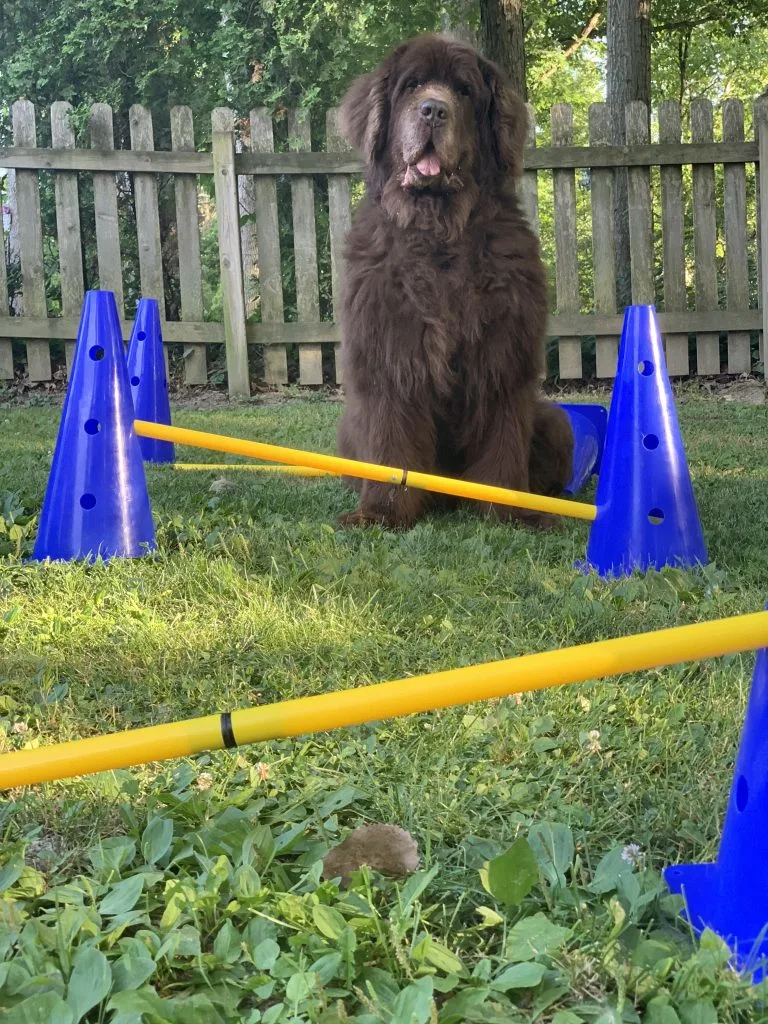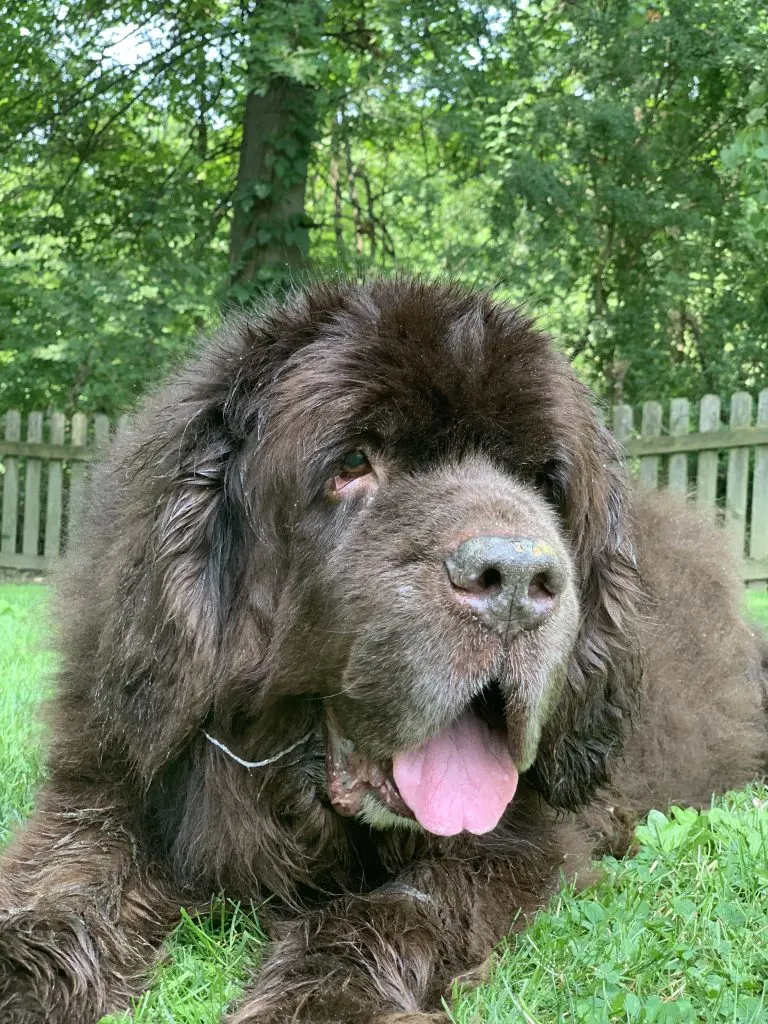I used to think that raising a teenage Newfoundland was easy and then they became seniors and I really had a wake-up call.
Senior Newfies are amazing and beautiful but they’re also a lot of work.
They’re a lot of work because they’re a giant breed dog and giant breed dogs tend to lose mobility faster than breeds of dogs that are smaller.
Their average lifespan is 10-12 years old but many Newfoundlands are living well into their teens these days with a healthy diet, proper exercise and stellar care from their owners and veterinarians.
I’ve lost a Newfoundland due to mobility issues and I’m bound to lose one again but the more I learn the more I can do my best to prolong that.
The below exercises are some that I’ve been using on both Sherman and Leroy in their senior years but they are also good for healthy adult Newfies too.

My Brown Newfies is a participant in the Amazon Services LLC Associates Program, an affiliate advertising program designed to provide a means for sites to earn advertising fees by advertising and linking to Amazon.com
Before You Begin Exercising Your Senior Dog
Before you begin exercising your senior Newfoundland dogs it’s important to make sure that they have been given a complete physical exam by your veterinarian and that they have been cleared to perform these exercises.
A senior exam is a great way to stay up your older dogs health and should be completed at least once a year but preferably twice.
It’s also important to make sure that your older dog isn’t suffering from issues that could cause him more pain.
The key to exercising senior dogs is to start off slow and gradually build up over time and to be consistent.
Exercises for senior dogs should be tailored for the individual dog and their needs and always under the advice of a veterinarian or physical therapist.
It’s important to give them a warm-up period with some basic flexes and also a warm down period with a massage in order to keep their muscles loose.
Never push your senior dog if they seem to be struggling or in pain!
Why It’s Important To Exercise Your Senior Dog
Just like an adult dog, senior Newfies need exercise too. It’s easy for owners to say, “He’s getting old. I should let him rest.” or “He’s too old to do that.”
Keeping a senior dog moving through exercise is good for their heart, keeps their weight in check, helps maintain muscle and keeps their joints moving.
It’s easier to maintain muscle on a senior dog than try to get it back and daily exercise can help keep the muscle from deteriorating too much.
Also, exercising your senior dog is a great bonding time and it keeps dogs happy and their minds active.
Coordination/Balance Exercises For Senior Newfoundland Dogs
High Stepping
High stepping can be done with a few cones and poles, (cavaletti or hurdle equipment)
This exercise is used for improving cardiovascular endurance, proprioception, active range of motion and muscular strength in all limbs.
Using this in a straight motion can help rebuild a dog’s natural walk. This is exactly why I’m using this on Leroy because of his tendency to shuffle his back legs rather than pick them up.

You can also arrange the poles to go in a circular pattern or you can set the poles at different heights which will encourage a greater range of motion, will require full weight bearing on all limbs and challenges proprioception, balance and coordination.
Weaving.
Weaving can be a great proprioceptive exercise. Proprioceptive is the body’s ability to sense itself.
This is something that Leroy has struggled with over the past year with his left rear leg. He’s gotten a lot better but there is still room for improvement.
Weaving through a few cones can help with backend coordination also.
Platform Stands/Weight Shifting
Platform training works to strengthen your dog’s muscles and improve balance
You can either build a platform or buy one.
Some platform exercises include putting two paws in it, backing up onto it, side-stepping onto it, and placing the back paws on it while the front paws are on the floor.
(We have a few sheets of foam insulation board that we’ll be making into a platform stand eventually)
Walking Backwards
Walking backward is a core muscle activity that every dog can do but it’s harder for some dogs to accomplish this.
This motion assists with balance and proprioception of the rear legs, as well as the rest of the body.
It sounds easier than it is so before starting off you may want to try this down a hallway or between 2 gates to set a path for you and your dog to follow.
Start off slow and gradually increase.
(I don’t do this one with Leroy yet because he tends to stumble more than actual walk)
A great exercise to teach adult Newfies!
Strength Training Exercises For Senior Newfoundland Dogs
Hill Work
Small hill work is by far my favorite strength training exercise to do with Leroy.
Hill work is a low-impact exercise great for building rear end strength and coordination.
We’re lucky enough to have a grade to our driveway which provides a sloping hill alongside it. The hill goes from about 15 feet to flat.
Right now I’m starting Leroy around the 12-foot slope area and we go up, go down and then move over a few inches. We do this about 10 times every other day.
I’ve noticed a huge change in his back leg strength since doing this and I’ve also noticed better coordination with that left rear leg that’s been giving him some issues.
Swimming
Swimming is one of the best if not THE best low-impact exercise for dogs of any age.
Water reduces the painful pressure on the joints and allows freedom of movement that is more difficult on dry land
If you have access to a lake, pond or swimming pool and your dog likes water, this is an ideal way to exercise them.
If you don’t have access to a big body of water for your dog to swim you can check with local veterinarian offices to see if they offer hydrotherapy.
Walking
If your senior dog is able to go for walks, short walks every day is a great way to keep their muscles intact and their body moving.
Even senior dogs with mild arthritis can benefit from walking daily.
You can do short walks in the morning and evening and try to have them walk on the grass instead of the cement to keep it lower impact on their joints.
Sit to Stand
Doing a few repetitions with your dog from a sit to stand can help strengthen their rear leg muscles and help with balance.

If You Have a Senior Newfoundland That Can’t Do These Exercises
If you have a senior Newfie like Sherman that can’t do many of the above exercises there are still exercises and physical therapy you can do.
Passive Range of Motion (PROM)
Many range of motion exercises can be done when a dog is laying down and under.
You can speak to your veterinarian or physical therapist and ask them to show you how to properly do ROM exercises or check out the book, The Healthy Way to Stretch Your Dog: A Physical Therapy Approach
Acupuncture
Acupuncture improves blood flow which increases oxygenation of tissues. It also reduces the number of waste products produced and increases the amount of metabolic waste the body can remove, so there is a systemic benefit.
Acupuncture relaxes muscles both where the needle is inserted, and muscles located elsewhere in the body, so it relieves pain both locally and generally.
By stimulating the release of naturally occurring pain relieving and anti-inflammatory substances, acupuncture may decrease the amount of pain medications needed to treat these dogs.
Massage
Massage therapy on a dog can help improve muscle and joint function by relieving tension, spasm, or other restrictions to proper motion.
It may be used for warm-up purposes, for relaxing or to stimulate muscles in order to prevent injury.
Massage is also used to help circulation by increasing the normal flow of blood and lymphatic fluid the normal flow of blood and lymphatic fluid
Check out: Physical Therapy and Massage for the Dog
Laser Treatment
Therapeutic laser therapy uses light energy, which is cold or low-level.
Light used at specific frequencies causes a physiological change at the cellular level.
These changes can include replenishing adenosine triphosphate, reducing inflammation and decreasing pain transmission.
We are currently using a product called the Dog Med Laser which is low-level, in-home laser treatment. (More coming on this soon)
While the exact method of action for laser therapy has not yet been identified, it is thought that, in essence, it provides a “jump start” to the cells needed for healing and other body processes.
Hydrotherapy
Hydrotherapy is a type of water therapy designed to increase a dog’s strength and improve mobility in water.
Senior Exercises That We’re Currently Doing
I’ve been working daily with Leroy on his backend coordination and rear leg strength.
As some of you may remember, last year Leroy had really bad mobility issues due to being on steroids for a long period of time.
He was experiencing paw knuckling with his left rear, he had severe muscle atrophy and he needed help standing and walking.
Taking Leroy off the steroids and switching to another medication was the easy part.
Getting his mobility back has taken us almost a year and we’re still not all the way there yet.
To try and keep Leroy on track I’ve been concentrating on hill work and this month we added in the cavaletti work.
He’s been doing great and his paw knuckling is almost non-existent at this point.
He still has rear end weakness but it’s slowly improving.
I’ve been really focusing on proprioceptive exercises because Leroy has an issue with knowing where his back legs are in space.
It’s partly due to his weakness and part due to Leroy being a klutz.
It’s been really fun working with him and it’s a great way to exercise in the summer when it’s too hot to for walks.
I’ve been asked about which cavaletti poles we got and these are the ones that I ordered: Get Out! Hurdle Cone Set
They’ve been working great and they come with a bag to carry everything in!
The last few months have been really rewarding seeing Leroy get stronger even though he’s 11 years old and it’s been a great bonding time for us.
Since Leroy is super treat motivated I give him his dog food as a treat instead of loading him up with calories!
Related: Products That Can Help Keep Senior Dogs On Their Paws
Jan
Monday 15th of July 2019
So many choices and varieties of motion. I had no idea. These can all be fun to do with your senior dog instead of eating bonbons and watching TV.
Jen
Thursday 18th of July 2019
I'm having so much fun doing these exercises with Leroy!